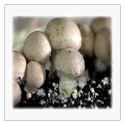|
|||||||||||||||||||
|
Types of Drugs
Mushrooms and Hallucinogens
Hallucinations may occur spontaneously in humans in cases of psychoses, and among these, the most common is the mental illness called schizophrenia. May also occur in normal people (who have mental illness) who take certain substances that are referred to as drugs or hallucinogenic substances, namely, that "generate" hallucinations. These are also called psicoticomiméticas for "imitate" or "mimic" one of the most obvious symptoms of psychosis - hallucinations. Some authors also call psychedelic, which means expansion of the mind, of course, an exaggeration. This is because the hallucinations and delusions have nothing to increase the activity or mental capacity: on the contrary, are aberrations, disruption of the perfect functioning of the brain, both which are characteristic of diseases known as psychosis. The large number of hallucinogenic drugs come from nature, especially plants. These were "discovered" by humans from the past that the feeling the mental effects of them, come to think of it as "divine plant", ie, that caused, whom ingested, receive divine messages from the gods. So today, indigenous cultures of various countries, the use of these hallucinogenic plants has religious significance. There are also considering that some of these hallucinogens act at very small and almost exclusively affect the brain and therefore almost not change any other function's body: they are themselves, or hallucinogens hallucinogens primary. THC (tetrahydrocannabinol) of marijuana, for example, is a hallucinogen primary. But there are other drugs that are also able to act in the brain, producing mental effects: they are hallucinogenic effects. The best-known hallucinogenic plants are mentioned below: Mushroom: The use of mushrooms became famous in Mexico, where, since before Christ, it was used by the natives of that region. So today it is known that the "sacred mushroom" used by some shamans. He received the scientific name Psylocybe Mexican and it can be extracted substance powerful hallucinogen action: psilocybin. Jurema: The Jurema wine, prepared on the basis of the Brazilian plant Mimosa hostilis, popularly called Jurema, is used by the remaining Indians. The effects of wine are well described by José de Alencar in the novel Iracema. It is only used in candomblé during New Year's Eve. Jurema synthesizes a potent hallucinogenic substance, the dimethyltryptamine or DMT, responsible for the effects. Mescal or Peyolt: (Lophophora williamsii) - This is a cactus, used since ancient times in Central America, in religious rituals. This plant produces the hallucinogenic substance mescaline. Cactus Mescal was part of the rituals of indigenous peoples of Central America in the southwestern United States. The peyolt is still used legally in many indigenous rituals, through a sacrament recognized by the Native American Church. Caapi and viridis: There are two hallucinogenic plants that are used together in the form of a drink that is consumed in the Santo Daime ritual or worship of the Plant and various other sects. In Peru, the drink prepared with the two plants is called by the Quechua Indians of ayahuasca, which means "wine of life." The hallucinations produced by the drinks are called mirages, and the leaders of this religion seek to "lead them" to the spiritual dimensions of life. Atropa belladonna: A Atropine is found in large quantities in Atropa belladonna, a plant native to Europe that now stretches the United States. Their berries are sweet (which represents an attractive risk, especially for children), but with particularly high rates of atropine. The Hyoscyamus niger (meimenbros) contains large amounts of scopolamine. Stramoniun Datura (Datura or tree-of-hell): The Datura Stramonium (estramonio or tree from hell) and a plant native to North America All plant parts contain large quantities of atropine, scopolamine and related compounds. Datura''species''were used in Native American rituals. An incident occurred in Jamestown, Virginia, led to its alternative name "Jimson" or "Jamestowm weed" (something like "Jamestown weed"). Jamestowon soldiers sent to quell a riot remained disoriented for nearly two weeks when the datura was inadvertently placed in his food. Nutmeg and their shells: They contain hallucinogenic substances miristicim and elemicim. The chemical structures of these are, like mescaline, similar to amphetamine or norepinephrine created in the laboratory, but the effects are more like those of LSD. Use them often occurs when the substances Tracks are not available. Vines "morning glory" (Morning Glory) are found in many places. The name of some, for exenplo "Heavenly Blue" (blue), can indicate the potential hallucinogen. The seeds contain most of the hallucinogenic chemicals. One of the substances synthesized by plants is the DMT, already discussed in relation to the Jurema. Effects on the brain: The reactions are rich and psychological variables. Sometimes they are nice (good trip) and the person feels rewarded by the unusual sounds, bright colors and the hallucinations. At other times, the mental phenomena of nature are nasty, terrifying visions, sensations of deformation of the body, certainty of imminent danger, etc.. Are the bad trips. Both good and bad trips can be driven by environmental concerns earlier by (the experimenter know when stubborn is not a "good head" to take the hallucinogenic) and especially by a person on the side. This is the role of guide or priest in various religious rituals, which, together with the environment of the time, songs, etc.. Are capable of conducting the mental effects to the side you want. Effects on the body: General: |
||||||||||||||||||

 The word delusion means in medical language, perception without objective, that is, the person who is in the process of hallucination without notice things they do. Thus, when a person hears imaginary sounds and see objects that do not exist, it is having an auditory hallucination or visual hallucination.
The word delusion means in medical language, perception without objective, that is, the person who is in the process of hallucination without notice things they do. Thus, when a person hears imaginary sounds and see objects that do not exist, it is having an auditory hallucination or visual hallucination.